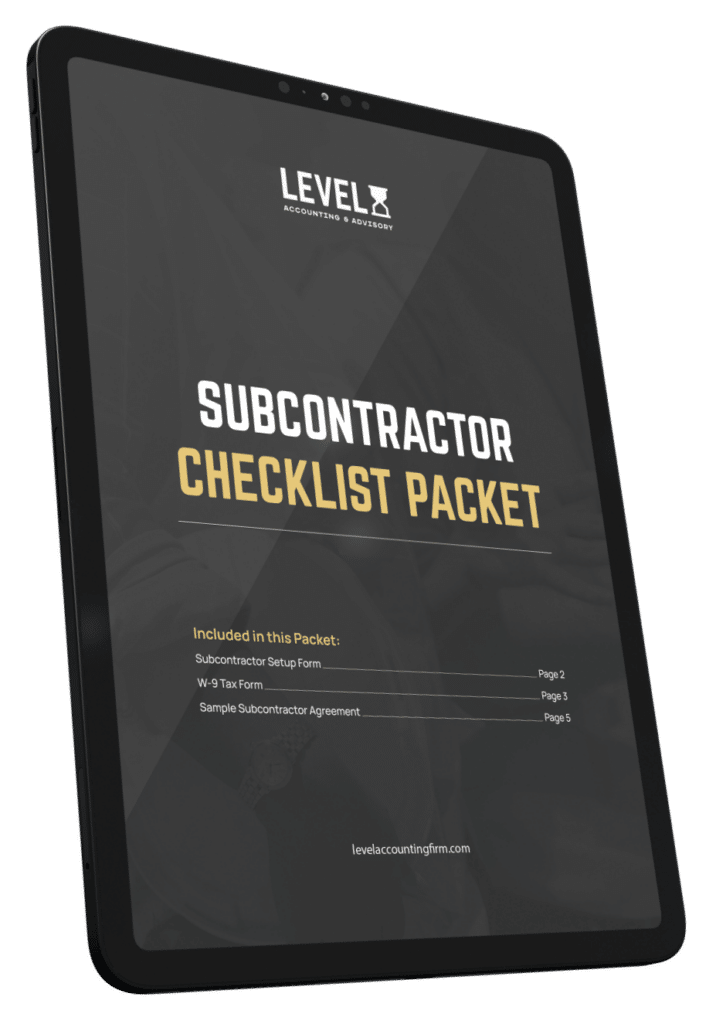Today, we’re tackling a subject that’s crucial for many of our clients at Level Accounting Firm: preparing and filing personal tax returns for contractors. Navigating contractor taxes can seem daunting at first, but with the right guidance, you can smoothly sail through the process.
Let’s break it down into manageable steps to ensure you’re well-prepared and compliant with tax laws, making your tax season stress-free.
Understanding Your Tax Obligations as a Contractor
First things first, let’s understand what it means to be a contractor from a tax perspective. Unlike traditional employees, contractors are considered self-employed by the IRS. This designation carries specific tax responsibilities, including paying self-employment taxes and making quarterly estimated tax payments. Recognizing your tax obligations is the cornerstone of properly managing your contractor taxes.
Moreover, as a contractor, you’re entitled to deduct business expenses directly related to your work. These deductions can significantly lower your taxable income, hence why it’s crucial to keep meticulous records. From home office expenses to travel costs, understanding what qualifies as a deductible expense is pivotal. By doing so, you not only comply with tax regulations but also maximize your earnings.
Organizing Your Financial Records
Organization is key when it comes to taxes, especially for contractors. Having all your financial records in order simplifies the process of filing your tax return. Begin by collecting all of your earnings documents, including 1099 forms from customers who have paid you a total of $600 or more in the fiscal year.
If you’ve received income from clients who do not provide a 1099 form, you’re still required to report it. Hence, tracking every penny you earn is crucial.
Equally important is keeping receipts and records of all your business-related expenses. These records should be detailed, including the date, amount, and purpose of each expense. Utilizing accounting software or apps specifically designed for contractors can be a game-changer in maintaining organized financial records. This preparation not only aids in filing your tax return but also in the unfortunate event of an IRS audit.
Calculating Your Taxable Income
Once you’ve organized your financial records, the next step is to calculate your taxable income. This involves subtracting your business expenses from your total income. The resulting figure is your net income, which will be subject to income tax and self-employment tax. Accurately documenting your earnings and expenditures is crucial in order to prevent any possible complications with the IRS.
Remember, certain expenses are fully deductible, while others may have limitations. For instance, home office expenses are deductible based on the percentage of your home used for business. Understanding these nuances can significantly impact your taxable income, so it might be beneficial to consult a tax professional if you’re unsure.
Making Estimated Tax Payments
A significant aspect of managing contractor taxes is making estimated tax payments throughout the year. Since taxes aren’t withheld from your paychecks as a contractor, the IRS requires you to make quarterly estimated tax payments. These payments address your responsibilities for income tax and self-employment tax.
Not paying estimated taxes can result in fees and additional charges. Therefore, it’s vital to estimate your annual earnings and calculate your quarterly payments accordingly. The IRS provides forms and worksheets to help you estimate these payments. Additionally, paying a little extra can help avoid underpayment penalties, providing a buffer if you underestimate your income.
Filing Your Tax Return
When tax season arrives, it’s time to compile everything you’ve prepared into your tax return. You’ll likely need to file Schedule C (Profit or Loss from Business) alongside your standard Form 1040. Schedule C is where you report your income and expenses, ultimately determining your taxable income.
Moreover, you’ll need to calculate your self-employment tax using Schedule SE, which covers Social Security and Medicare taxes. Remember, you can deduct half of your self-employment tax when calculating your adjusted gross income, which can lower your tax bill.
For many contractors, the process might seem intricate and overwhelming. However, leveraging tax preparation software or consulting with a contractor accountant can streamline the process. These resources ensure your tax return is accurate and compliant with tax laws, minimizing the risk of errors.
Prepare and File Your Tax Return with Level Accounting
Preparing and filing your tax return as a contractor doesn’t have to be a daunting task. By understanding your tax obligations, organizing your financial records, accurately calculating your taxable income, making estimated tax payments, and meticulously filing your tax return, you can navigate contractor taxes with confidence. Remember, staying informed and seeking professional advice when necessary can make all the difference in managing your taxes effectively.
At Level Accounting Firm, we understand the unique challenges contractors face during tax season. Our team is dedicated to providing the guidance and support you need to optimize your tax situation. Whether you’re looking for advice on deductible expenses or assistance with tax filing, we’re here to help.
To learn more about how we can help you prepare and file your tax return, contact us today to get started.


